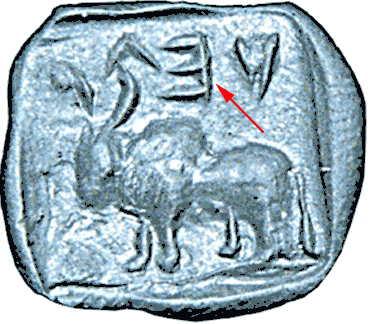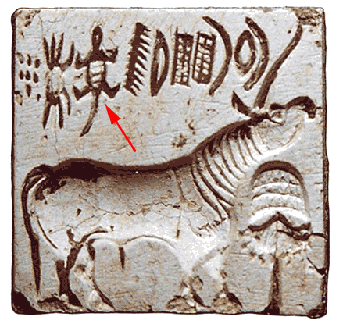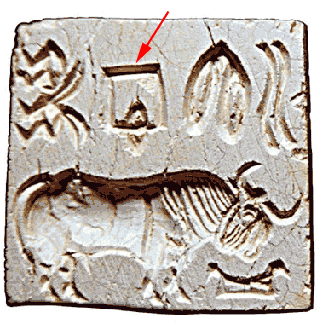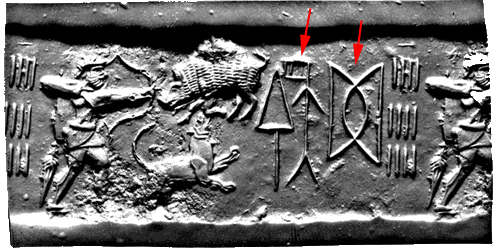'Singletons' in Unpublished
Indus Seals
Early Support for
'Sproat's Smoking Gun'
Steve Farmer, Ph.D.
Go to Indus slide-lectures
available online
(Illustrations of new seal inscriptions
used as evidence are provided at the end of the page.)
One
of many arguments that demonstrate that Indus symbols were not part of a
'writing
system'
revolves around the fact
that as the size of the known corpus of Indus inscriptions expands it shows
no signs of symbol 'saturation.' Put simply, all this means is
that as the number of known
inscriptions increases, the percentage of unique signs ('singletons')
and other very low-frequency Indus signs keeps rising rather than falling — which
is the opposite of the behavior expected from a true
writing system. This finding leads to predictions concerning what we will
find in
Vol.
3 of the Corpus of Indus Signs and Inscriptions, whose imminent
publication was announced at the May 2001 and May 2002 Harvard Roundtable
meetings.
(No such announcement was made at the May 2003 or May 2004 Roundtables.)
For
predictions of this sort, go to http://www.safarmer.com/smokinggun.html,
which is extracted from my lecture at the May 2003 Harvard Roundtable. For
this and more recent slide-lectures and articles on the Indus seals, Go
to Indus slide-lectures available online.
Depending
on who is counting Indus symbols, current
estimates
of the
number
of 'singletons' in relation to all known Indus signs range
from 27% - 50%, with much higher percentages consisting of very low frequency
signs. Moreover, there are strong reasons to argue that these already
implausibly high numbers are badly underestimated. For discussion,
see page 16 of indusnotes.
The
suggestion of this evidence is that a significant number of Indus signs
were created 'on the fly'
and
were
used
only once or a handful of times before being abandoned. This is consistent
with the behavior of many known nonlinguistic sign systems, but not with a fully
enabled 'script.'
It
is interesting to note that an unusually high percentage of 'singletons'
and other low-frequency
signs
show up preferentially
on the best-quality Indus seals. This strongly suggests that, for whatever
reason, creation of new Indus symbols was apparently largely the
prerogative of Indus elites. There are far-reaching implications to this
finding that
it is important to take up at another point.
While
we're waiting for Vol. 3 to be released, we can take a look at some interesting
seal inscriptions, none in the current volumes of the Corpus, that
we know will show up in that volume. In the Schoyen Collection in Oslo,
Norway, eight Indus
seals
can
be found that
carry the label: "To be published
by Asko Parpola in: Corpus of Indus Seals and Inscriptions, vol.
3."
For
all eight Indus seals, their impressions, and (unfortunately often very
badly misleading) catalog descriptions, consult
(besides the annotated images that I include on this page below) http://www.nb.no/baser/schoyen/5/5.6/.
Then scroll down to 16.4, Indus cylinder and stamp seals:
The catalog entry provides superb images
of eight previously unpublished Indus seals due to be printed in Vol. 3
of the Corpus. Using the Schoyen Collection reference numbers,
they are:
* MS 4602 Indus Valley, ca. 3000 BC
* MS 5062 Indus Valley, 2200-1800 BC
* MS 5065 Indus Valley, ca. 1800 BC
* MS 2645, Afghanistan, 23rd-21st c. BC
* MS 4617, Indus Valley, ca. 2200-2000 BC
* MS 4619, Mohenjo-Daro, ca. 2200-1800 BC
* MS 5059, Indus Valley, 2200-1800 BC
* MS 5061, Indus Valley, 2200-1800 BC
Seven
of those eight seals carry inscriptions. It is a bit difficult to read a
few of the signs, but there is no doubt
that at least four of the eight seals carry new 'singletons'
not
seen
in
earlier
inscriptions. All these seals are very high quality — the kind (one
notes euphemistically) that invariably 'find their way' into 'private collections.'
(Many of the best Indus pieces, still largely unpublished, unfortunately
fall into this looted category.) The high quality of the inscriptions supports
the general impression that,
for
whatever
reason, the creation of new signs was largely the
prerogative
of Indus
elites.
The
upshot: the preliminary evidence from Vol. 3 confirms the prediction that
the number of 'singletons' can be
expected to continue to grow even larger as the number of known Indus inscriptions
increases. Even though I have not seen Vol. 3, I have been able to gather
enough data
over the last few months from recently published sources that also confirms
that prediction. From the preliminary data, it does not appear that the
130-year-old 'Indus script' myth will survive publication of Vol.
3 of the Corpus.
(Since
this note was written, I have been given full access to the 500-odd unpublished
inscriptions from Harappa in the Harappa Project data base at
Harvard University; study of these unpublished inscriptions further confirms
that prediction. Some of these unpublished inscriptions are shown in recent
slide lectures found at my download
page.)
Below
are my annotations of the four (out of seven) inscribed seals illustrated
in the Schoyen Collection that
contain new 'singletons.' There are many other interesting anomalies in
these seals
that
I won't try to discuss here.
For
the original images, go to the Schoyen collection. The partial images used
below with arrows added are
cited under 'Fair Use' provisions of copyright law, which permits reproduction
of this sort for scholarly purposes.
Modern
seal impression of a previously unpublished Mohenjo-daro seal. (The
animal
in this impression is anomalously facing left, not right as usual.)
At a minimum, the sign marked by the arrow is a 'singleton' — no
other instances of the sign is known in any previous sign list.(The
closest known
sign
is the
multi-toothed
object, sometimes referred to as a 'comb,' seen in the middle of inscription
MS 5059, which is shown immediately below. The so-called
comb in MS 5059 is often associated with farm instruments and plant
signs, and, judging from
context, most likely represented a harvesting tool.)
For a large image of the original seal and
the seal impression seen on the right, go to the Schoyen
Collection in Norway:
http://www.nb.no/baser/schoyen/5/5.6/
Scroll down to 16.4, click on MS 5065, and then click on the small
image when it appears.
.
|
|
Another large and beautiful Indus seal from
Mohenjo-daro, also previously unpublished, to the best of my knowledge.
The photo of the seal is flipped horizontally
to mimic
the way it
would look as a seal impression. The reptilian-looking (?) creature
that is the third symbol from the left is an apparent 'singleton.'
The
sign
is not given in any of the previously known sign lists.
For large image of the seal and an impression
go to the Schoyen Collection:
http://www.nb.no/baser/schoyen/5/5.6/
Scroll down to 16.4, click on MS 5059, and
then click on the small image when it appears.
|
|
Large
beautiful Indus seal from Mohenjo-daro, also apparently previously
unpublished. The photo of the seal is flipped
horizontally to mimic
the way it
would look as an impression. The second symbol from the left (see
the red arrow) is a 'singleton' — no other instances of the
sign is known in any previous sign list.
For a large image of the seal and an impression
go to the Schoyen Collection:
http://www.nb.no/baser/schoyen/5/5.6/
Scroll down to 16.4, click on MS 5062, and
then click on the small image when it appears.
|
|
Impression
of a rare Indus cylinder seal — a form more common to the Indus
Valley's Mesopotamian trade partners than to Harappa itself. Found
in this case in NW Afghanistan.
As the Schoyen catalog description suggests, the iconography
appears
to be
Old Akkadian,
while
the symbols are easily identified as being Indus. (The three rows
of four strokes and the hoe or spear-like sign are familiar Indus
symbols.) The two middle symbols or emblems, however (red arrows),
are not found in any
other
inscription
(out of a data base of perhaps by now 20,000+ [?] known
instances of individual Indus emblem occurrences).
For a large image of the original seal and this
impression, go to the Schoyen collection in Norway:
http://www.nb.no/baser/schoyen/5/5.6/
Scroll down to 16.4, click on MS 2645, and then
click on the small image when it appears. |
|



